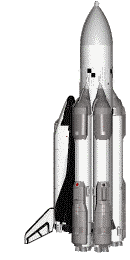L-1 (Zond) / BlockD (1/30)
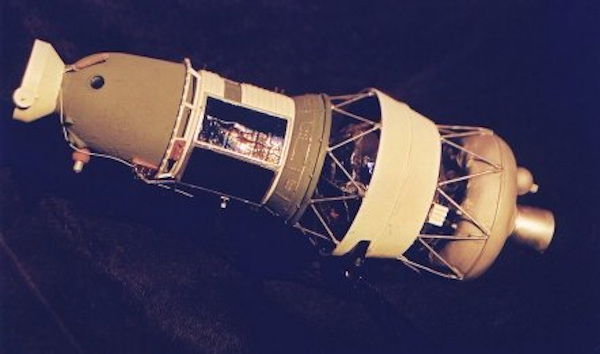
I fully engaged my propensity for the obscure with this model... this is the Soviet circumlunar manned spacecraft of the late 1960s that never flew to the Moon manned, though it did several times unmanned.
Unlike the Americans, who used the Apollo-Saturn V for their lunar landing missions (e.g., Apollos 11, 12, 14, 15, 16 and 17) as well as their lunar orbiting only missions (e.g., Apollos 8 and 10) and their circumlunar mission (i.e., what Apollo 13 became) , the Soviets had an entirely separate spacecraft and booster for their circumlunar missions. For circumlunar missions the Soviets planned to use the L-1 or "Zond" spacecraft launched by the Proton booster) (click for photo of the author in front of a Proton rocket), while for the lunar landing missions the L-3 spacecraft launched by the N-1 booster (click to go to N-1 section) was to be used. Historians now view this duplication of effort as an important factor in the Soviets lagging behind the American program to land a man on the moon in the 1960s. Of course, little of this was common knowledge at the time, and has only become public since the fall of the Soviet Union.
In 1968 it was recognized that the Soviets with their "Zond" spacecraft were developing the capability to send a man around the Moon, as they had completed several unmanned Zond missions around this time with varying levels of success. This knowledge (with more details coming from the CIA) motivated the Americans to expedite the Apollo program, and on only the second manned Apollo flight, and the first with the huge Saturn V booster, the Americans sent Apollo 8 on a lunar orbiting mission at Christmas 1968. It appears that the Soviets subsequently lost interest in sending a man around the Moon after Apollo 8, presumably seeing little propaganda value in such a feat anymore, and never did send a manned Zond (L-1) around the Moon.
This model depicts the L-1 spacecraft still attached to the last booster stage of the UR-500 "Proton" launch vehicle. This is the configuration the spacecraft would have just after completion of the boost phase, on the way to the Moon. The model is based on the rare Soviet-era Ogonjek 1/30 Soyuz (click for photo of model) kit's decent and service modules (the orbital module has been removed) with extensive modifications. The Block D stage has been entirely scratch built.
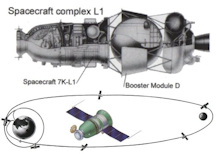 L-1/Block D spacecraft diagram, with circumlunar flight path
L-1/Block D spacecraft diagram, with circumlunar flight path
(click to enlarge)
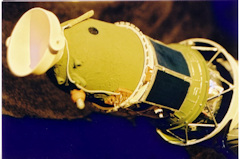 L-1/Block D model (front - click to enlarge)
L-1/Block D model (front - click to enlarge)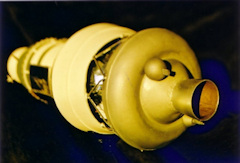 Detail of
L-1/Block D model (rear - click to enlarge)
Detail of
L-1/Block D model (rear - click to enlarge)Proton-Mir & Proton-L-1 (Zond) (1/144)
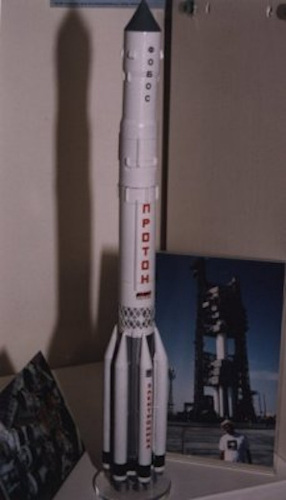
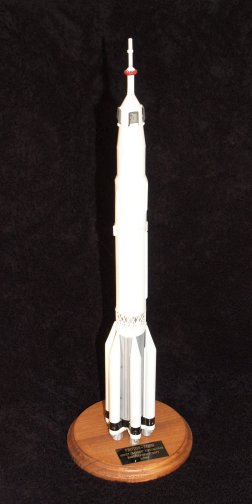
The Proton booster (also known as the UR-500) was developed by the Soviet Union in the mid-1960s and is roughly comparable in lifting power to the American's smaller Saturns. The Proton is considered to be a heavy-lift launch vehicle and is still in use today. It has been used to launch the modules of the Soviet/Russian space stations (i.e., the Salyuts and Mir) and later the Russian-built modules of the International Space Station (e.g. Zarya and Zvezda). The Proton was also the booster for the Soviet manned circumlunar mission, which was planned but never flown manned in the late 1960s/early 1970s.
Unlike many other Soviet boosters developed in the '50s and '60s, like the R-7 derivatives (e.g., Sputnik, Vostok or Soyuz launchers) or the N-1 (Soviet manned Lunar landing booster), all of which were designed by Sergei Korolev's design bureau OKB-1 and all of which burned kerosene and super cold liquid oxygen in their lower stages, the Proton was designed by Vladimir Chelomei's OKB-52 design bureau and burned fuels that could be stored at room temperature. Archival information that has become available since the fall of the Soviet Union indicates there was intense competition between these two bureaus for the job of developing the booster for the manned lunar landing mission.
While Korolev's bureau was considered preeminent, having been behind virtually all of the early Soviet victories in the Space Race, and eventually was awarded the prestigious assignment of developing the booster for the Soviet manned lunar landing, Chelomei's bureau had important connections. Soviet Premier Nikita Khrushchev's son Sergei was an engineer with OKB-52 and, perhaps in part for this reason, it was also given a prestigious task - development of the booster for the manned circumlunar mission.
Unlike the Americans, which used the Apollo-Saturn V for both missions, the Soviets planned to use entirely separate spacecraft and boosters for their manned circumlunar vs. lunar landing programs. Historians now view this duplication of effort as an important factor in the Soviet effort lagging behind the American program to land a man on the moon in the 1960s.
The Proton was not powerful enough to send the three module Soyuz (click for diagram of Soyuz modules) manned spacecraft to the Moon, let alone lift the additional fuel required if the spacecraft were to fire its rocket engines to enter, and again later to leave, lunar orbit. The Proton had just enough capability to send a stripped down Soyuz (i.e., the L-1 "Zond"), with the (relatively) spacious orbital module removed, on a circumlunar trajectory, looping around the Moon (i.e., it could not enter lunar orbit). This left only the crammed Soyuz descent module to accomodate the crew.
Although the L-1 (Zond) never did fly manned, the spacecraft had a crew capacity of two. Several unmanned Zond missions were flown in the late '60s and early '70s, sending turtles and other biological specimens on a circumlunar trajectory before splashing down in the Indian Ocean. However, as noted in the L-1 / Block D description above, the Soviets seemed to lose interest in flying a man around the Moon after the success of the American lunar orbiting Apollo 8 mission at the end of 1968, and never did fly the L-1 "Zond" manned, although the most observers believe that they easily could have.
The Proton-Mir model is built from a resin kit from one of the small "garage" space model kit manufacturers, now defunct, Rho Models of the Netherlands. You will note in the photo that displayed beside the model is the same photo of myself standing next to a real Proton rocket on the pad in Baikonour that appears on the home page of this website. The Proton-L1 (Zond) model is from a resin kit made by Realspace Models, and is also in 1/144 scale.
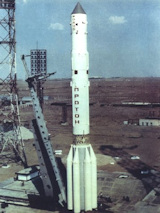 Proton-Phobos on the pad in Baikonour (click to enlarge)
Proton-Phobos on the pad in Baikonour (click to enlarge)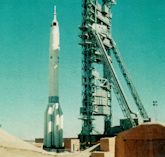 Proton L-1 (Zond) on the pad at Baikonour (click to enlarge)
Proton L-1 (Zond) on the pad at Baikonour (click to enlarge)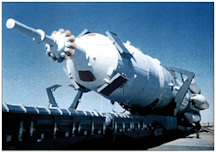 Proton L-1 (Zond) on the transporter at Baikonour (click to enlarge)
Proton L-1 (Zond) on the transporter at Baikonour (click to enlarge)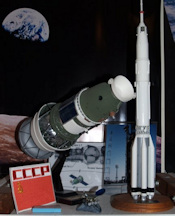 L-1 (Zond) / Block D (1/30) together with Proton / L-1 (1/144) in the Shrine (click to enlarge)
L-1 (Zond) / Block D (1/30) together with Proton / L-1 (1/144) in the Shrine (click to enlarge)N-1 (1/144)
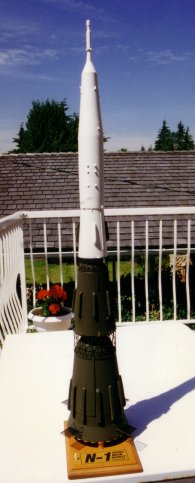
The N-1 rocket was the Soviet Union's counterpart to the American Saturn V in terms of lift capability and design purpose - its primary mission was to boost a manned spacecraft on a lunar landing mission (the Soviet "N-1 L-3" mission) in the late 1960s or early 1970s. Top secret at the time, though widely rumoured then and for years after, the first photos of the N-1 appeared in public only in the late 1980s (during the Soviet's "glasnost" era).
The N-1 (link to YouTube video) was huge, in some respects out doing the Saturn V (click for comparison of models from the Smithsonian). Like the Saturn V, the N-1 was designed for a lunar orbit rendezvous mission, meaning one manned spacecraft would stay in orbit around the Moon while another landed, and then later the two would be rejoined. The N-1 had 5 stages plus the lunar landing module (LK) and lunar orbiting command spacecraft (LOK). For further details on the N-1 L-3 mission and models of the Soviet Lunar Landing LOK and LK click here to go to page 6.
The first stage of the N-1 boasted 30 NK-33 engines, 24 around the perimeter and six more centrally located in a circular arrangement. Like the Saturn V first stage's five much larger F-1 engines, the N-1's thirty NK-33 engines burned kerosene and liquid oxygen. The lift-off thrust of the N-1 with these 30 engines was in the neighbourhood of 10 million pounds of thrust, one-third again larger than the Saturn V's 7.5 million pounds of thrust.
However, the N-1 overall had less weight-lift capability to Earth orbit, and beyond, than did the Saturn V. In part this was because all the upper stages of the N-1 also burned kerosene and liquid oxygen, unlike the Saturn V which burned the more difficult to handle but much more powerful combination of liquid hydrogen and liquid oxygen in its two upper stages. As well the Saturn V had some important design features that saved weight. The N-1's fuel tanks were huge spheres inside the outer walls of the rocket, while the outer walls of the Saturn V were part of its fuel tanks. The Saturn V's second stage had a common bulkhead that served as part of both its liquid hydrogen and liquid oxygen tanks (quite an achievement given the 100 degree difference in temperature between these two liquids) which saved an estimated 10,000 pounds in weight. So overall compared to N-1, the Saturn V was a better design and evidenced a more sophistocated level of technology.
The N-1's smaller lift capacity necessitated some compromises in the mission profile for the Soviet manned lunar landing and the design of the lunar spacecraft. For example, the Soviet lunar lander, the LK, was much smaller than the American Lunar Module (LM) (click for comparison diagram) and would only have the capability to take one man down to the lunar surface, while leaving a single crew member in lunar orbit in the LOK spacecraft, which was analogous to Apollo's Command and Service Modules (click for comparison diagram) ). Many observers have noted the greater inherent danger of the Soviet lunar landing plans, with only one man traveling down to the surface. For an excellent series of diagrams outlining the mission profile for the N-1/L-3 Soviet manned lunar landing mission click here.
All four launches of the N-1, between February 1969 and November 1972, ended in failure with none of them even getting to first stage separation. In reading the histories of N-1 development that have become available in recent years it is evident that the failure of the N-1 was not because of design flaw, but rather lack of quality control especially with respect to the engines and especially in the early stages of the project. What doomed the N-1 was the resulting problems and delays, in the context of the bizarre political and industrial rivalries taking place in the Soviet system, all beyond public eyes and the scrutiny you would have in an open society. Indeed, some aspects of the N-1's design are now recogized as exemplary. For example, the NK-33 engine is now recognised as being one of the highest performance LOX/kerosene rocket engine ever created.
By late 1972 the American Apollo Program was winding down following six successful landings of two man crews on the Moon, as well as two lunar orbit only missions (Apollos 8 and 10) and the "successful failure" of the Apollo 13 circumlunar mission. Seeing no propaganda value in further attempts, the Soviet government quietly shut down the N-1 program, we know now, in 1974. In fact, the now open Soviet archives reveal that the emphasis at that time shifted to the development of a new manned heavy-lift vehicle, the Energia rocket with its shuttle, the Buran (click to go to Energia-Buran section) , which finally made its appearance, briefly, in the late 1980s. In fact, much of the infrastructure originally developed for the N-1 was refurbished for use by the Energia-Buran. For example the N-1's pad was converted for use as the Energia-Buran's launch pad and the N-1's carrier/transporter was modified to serve as the Energia-Buran's transporter (photos taken by the author in Baikonour) , just as the Saturn V's facilities were converted for use by the American Space Shuttle..
This model is from a resin kit made by Realspace Models, and is in 1/144 scale.
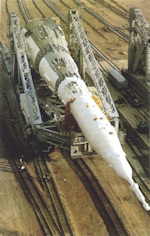 N-1 on transporter at Baikonour (1969) (click to enlarge)
N-1 on transporter at Baikonour (1969) (click to enlarge)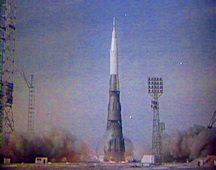 first N-1 launch, July, 1969 (click to enlarge)
first N-1 launch, July, 1969 (click to enlarge)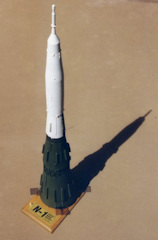 N-1 model (1/144) (click to enlarge)
N-1 model (1/144) (click to enlarge)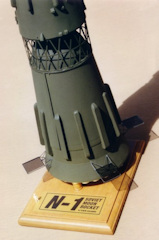 N-1 model (1/144) base - note size of man left of "N" for comparison
(click to enlarge)
N-1 model (1/144) base - note size of man left of "N" for comparison
(click to enlarge)Hubble Space Telescope and Space Shuttle Orbiter (1/100)
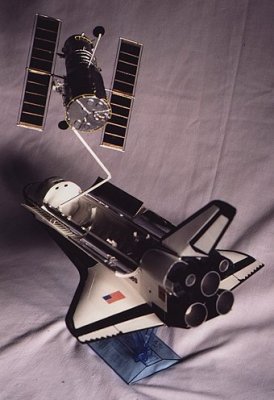
The Hubble Space Telescope (HST) was deployed from the Space Shuttle Discovery's cargo bay during the STS-31 mission in April 1990. As the largest optical telescope ever put into space it has expanded the visas of mankind considerably in the years since its deployment.
This model depicts a service mission in which the HST is grappled by the Remote Manipulator System (RMS, or "Canadarm") prior to it being brought into the Shuttle's cargo bay for refurbishment. The HST is entirely scratchbuilt and based upon a scale diagram I obtained from Lockheed in the late 1980s. The Shuttle Orbiter is based on the Tamiya kit. The model depicts an astronaut using a Manned Maneuvering Unit (MMU) attached to the HST, having presumably guided the telescope into a position where it could be grappled by the RMS. This is not the way it was been done on the actual HST repair/refurbishment missions, but this model was built about three years before the HST went into orbit.
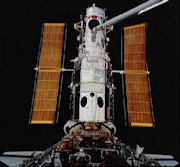 HST and the Shuttle's arm, STS-61, December 1993 (click to enlarge)
HST and the Shuttle's arm, STS-61, December 1993 (click to enlarge)
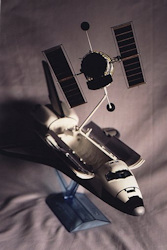 model of HST on Shuttle's arm (click to enlarge)
model of HST on Shuttle's arm (click to enlarge)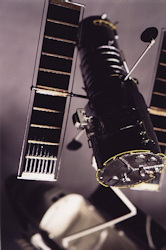 detail of HST model (click to enlarge)
detail of HST model (click to enlarge)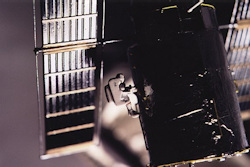 astronaut with MMU attached to HST (click to enlarge)
astronaut with MMU attached to HST (click to enlarge)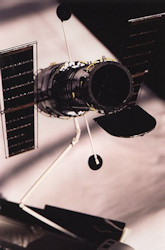 detail of HST model (click to enlarge)
detail of HST model (click to enlarge)Salyut 7 (1/96)
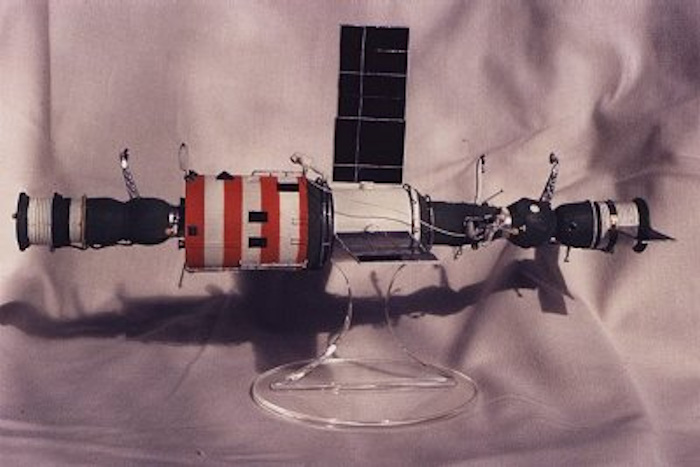
Salyut 7 was one of the "second generation" Soviet manned space stations. Like its predecessor, Salyut 6, Salyut 7 had two axial docking ports, front and rear. For the first time this afforded the possibilty of using supply ferries (i.e., an unmanned Soyuz variant called "Progress") to bring supplies to the orbiting space station crew by docking at one port while a crew return vehicle (i.e., the Soyuz manned spacecraft) remained docked at the other port. Neither earlier Soviet space stations nor the American Skylab had the capabilty to be resupplied in this way. Using unmanned re-supply ferries opened up the possibility for space station crews to spend much longer periods in orbit.
Launched in 1982 Salyut 7 was occupied virtually continually by rotating crews of cosmonauts until 1986-7, when it was replaced by the Mir space station. Like all Soviet manned spacestations and spacestation modules, Salyut 7 was placed in orbit by a Proton rocket.
This model depicts Salyut 7 in its early days, before additional solar panels were added. Docked at one end is a Soyuz-T manned spacecraft and at the opposite docking port is a Progress unmanned supply ship. The model was entirely scratchbuilt, although the Soyuz-T and Progress are based on polyester resin casts made from molds taken off Revell's 1/96 Soyuz from the Apollo-Soyuz Test Project kit. Two cosmonauts are depicted making a spacewalk.
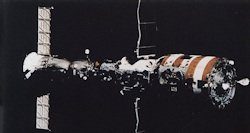 Salyut 7 space station with a Soyuz spacecraft docked to it in orbit,
mid-1980s (click to enlarge)
Salyut 7 space station with a Soyuz spacecraft docked to it in orbit,
mid-1980s (click to enlarge)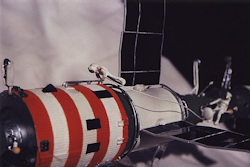 detail of Salyut 7 model (click to enlarge)
detail of Salyut 7 model (click to enlarge)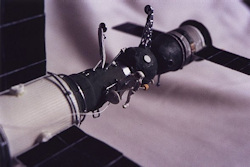 detail of Salyut 7 model (click to enlarge)
detail of Salyut 7 model (click to enlarge)
Energia-Buran (1/144 & 1/72)

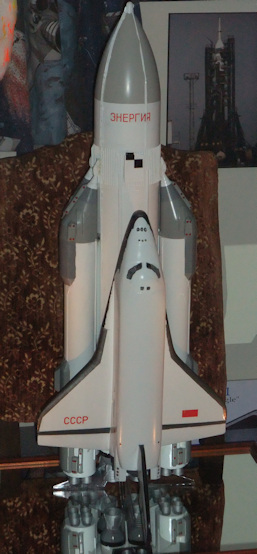
The Energia-Buran was the heavy-lift booster/space shuttle system developed by the Soviet Union in the 1970s and 1980s after the cancellation of the failed N-1 lunar booster program. The Energia-Buran combination only flew once in November 1988, unmanned, although it was designed for manned spaceflight. (click here to see a video of the only launch of the Energia-Buran)
Unlike the American "Space Transportation System" (i.e. "STS"), better known as the Space Shuttle, the Energia booster could fly independent of its plane-like orbiter (click here to see comparison). In fact, for the first launch of the Energia rocket in May 1987 a different payload was used substituted for the Buran orbiter. This was possible because, in contrast to the American STS arrangement, the main rocket engines on the Energia are not mounted on the orbiter, but rather on the mainstage of the rocket.
With the exception of the Saturn V and the N-1, the Energia was the most powerful rocket ever built up to that time - more powerful than the American Space Shuttle. Like the Space Shuttle's main engines, the Energia's main stage burned the powerful combination of liquid hydrogen and liquid oxygen, which by this time the Soviets had perfected (in contrast to the 1960s when this technology was not available in the development of the N-1). The Energia's four strap-on boosters burned kerosene and liquid oxygen. While originally designed for the Energia, in the early 1980's this strap-on booster was used as the first stage for a much smaller booster that was developed, the Zenit. (click to see Zenit photo) For more information on the Energia-Buran's launch and landing facilities go to the home page and see the description of my trip to Baikonour in 1992.
The first 1/144 scale Energia-Buran model I built is based on the resin kit from the now defunct firm Rho Models of the Netherlands. There is extra detailing on the engines and tiles, and the model was mounted (somewhat precariously) in an in-flight position using the base provided in the Airfix Space Shuttle kit.
A few years later a kit double that size became available. This is the A Models 1/72 scale Engeria-Buran kit. (click to see photo of kit box) This was the largest and most expensive model kit I personally have ever built. It required some new approaches simply because of the model's size & scale. For a start, while it might be optional in 1/144 scale, in 1/72 the model cries out for tile detail. While there are huge aftermarket decal sheets that can be purchased to detail the tiles on the American Shuttle, there is nothing like this for the Soviet Buran. However, I happened across on the net large and detailed graphic representations of the Buran's tiles. With some clean up in my graphics program, and some trial and error sizing, I eventually came up with home made tile decals for all surfaces on the 1/72 Buran. This worked quite well. Also, the very large component parts of this model were made from materials that I had not encountered before in modeling. In particular, the main stage was made of a material that seemed much like the type of plastic of which those large 2 litre soft drink bottles are made. I had a great deal of trouble gluing anything to this material. Eventually I used a hot glue gun to connect the major components of the model - crude, and a first for me. A very impressive model, this huge 1/72 Energia-Buran is now a featured part of the "1/72 Corner" of the Shrine that has evolved in recent years.
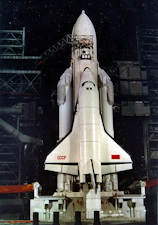 Energia-Buran on the pad in Baikonour, 1988 (click to enlarge)
Energia-Buran on the pad in Baikonour, 1988 (click to enlarge)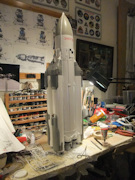 1/72 Energia model on workbench (click to enlarge)
1/72 Energia model on workbench (click to enlarge)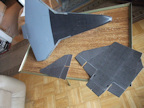 1/72 Buran model tile decals being applied (click to enlarge)
1/72 Buran model tile decals being applied (click to enlarge)(click to enlarge)
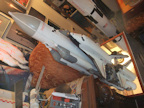 1/72 Energia-Buran model in the Shrine (click to enlarge)
1/72 Energia-Buran model in the Shrine (click to enlarge)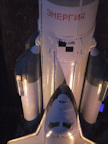 1/72 Energia-Buran model detail (click to enlarge)
1/72 Energia-Buran model detail (click to enlarge)Apollo 15 Trans-Earth EVA (1/32)
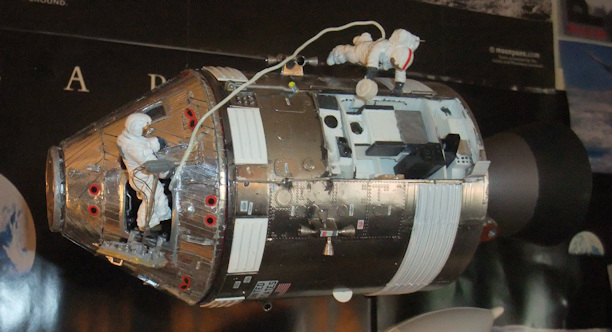
On August 5th, 1971 Apollo 15 Command Module Pilot Al Worden performed the world's first trans-Earth extra-vehicular activity (EVA), or space walk between the Moon and the Earth. The Apollo 15 Command and Service Module (CSM) Endeavour was then enroute to the Earth following the earlier successful landing on the Moon of the Lunar Module (LM) Falcon with astronauts Dave Scott and Jim Irwin onboard. Worden had waited patiently in lunar orbit for almost three days while the other two astronauts were on the Moon's surface, and this was to be Worden's big moment.
Worden was to exit through the main hatch, then proceed along the side of the Service Module to the SIM (Scientific Instrument Module) bay where he would retrieve film magazines from the Panoramic and Mapping Cameras, which had photographed the lunar surface while the CSM was in lunar orbit. Worden also took the opportunity to visually inspect the bay, since throughout the time in lunar orbit the SIM bay had experienced a few problems and it would be destroyed along with the Service Module when it later re-entered Earth's atmosphere at the end of the mission. Lunar Module Pilot Jim Irwin stood up in the hatch throughout Worden's EVA to spot and offer assistance if required, while Commander Dave Scott waited inside the depressurized Command Module.
This model is based upon the big 1/32 Apollo CSM kit first issued by Monogram in the early 1970s, and since reissued many times by both Monogram & Revell. While I had built this kit previously many years ago, since that time there have been issued many after market kits designed to enhance this kit specifically that provide much more detail. In particular, six (6) detail kits supplemented the basic Apollo CSM model kit for this project:
- Apollo Exterior Detail Set (New Ware)
- Apollo Command Module Interior (Real Space Models)
- Command Module Hatch (Real Space Models)
- Apollo 15 SIM Bay (Real Space Models)
- Apollo Astronauts (New Ware) for the Dave Scott figure in the interior of the CSM
- Apollo Astronauts Trans-Earth EVA Scene (Space Helment Models) for the Al Worden & Jim Irwin EVA figures
The mylar thermal protection on the outside of the Command Module was represented using strips of Bare Metal's chrome foil, applied in the pattern shown in David Weeks' drawings of the Apollo CM (available through Real Space Models).
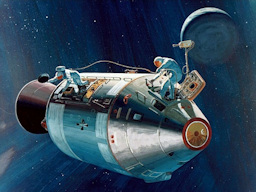 Al Worden's Trans-Earth EVA (artist's conception)
(click to enlarge)
Al Worden's Trans-Earth EVA (artist's conception)
(click to enlarge)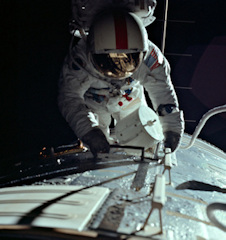 Al Worden's Trans-Earth EVA on Apollo 15 (click to enlarge)
Al Worden's Trans-Earth EVA on Apollo 15 (click to enlarge)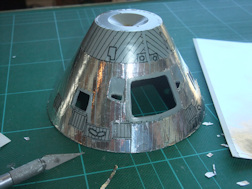 Apollo Command Module model with foil being applied (click to enlarge)
Apollo Command Module model with foil being applied (click to enlarge)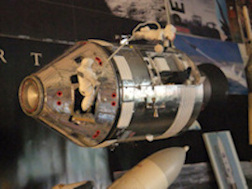 Apollo 15 Trans-Earth EVA model hung in the Shrine
(click to enlarge)
Apollo 15 Trans-Earth EVA model hung in the Shrine
(click to enlarge)Click here to return to the models of historic spacecraft and launch vehicles on the third, fourth and sixth pages. To return to the descriptions of my trips to space centres around the world, click here for the home page or the second page.
This page will change and evolve over time, so check back periodically. I welcome any questions or comments and can be contacted at:
Ken R. Harman last revision date: January 2021